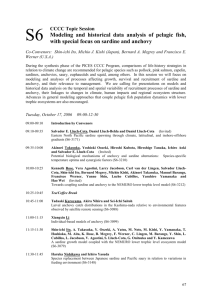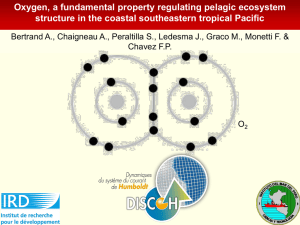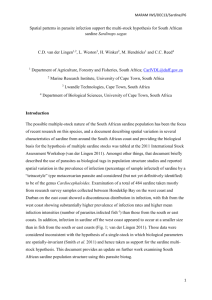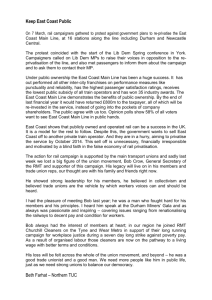MARAM_IWS_DEC13_Sardine_P7
advertisement
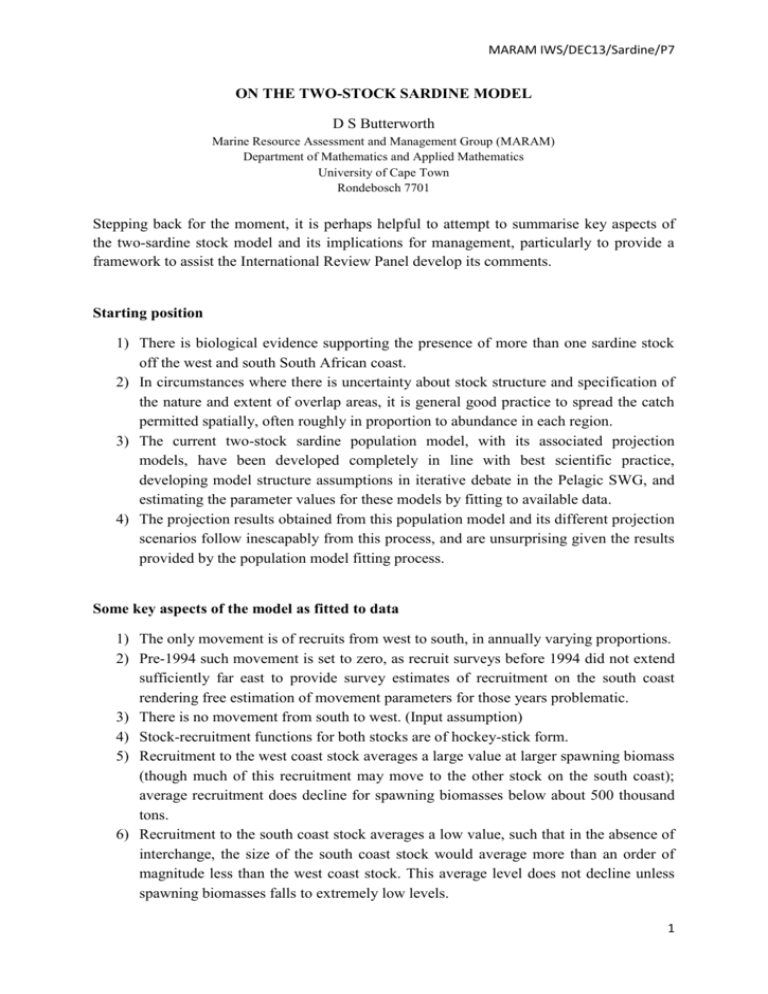
MARAM IWS/DEC13/Sardine/P7 ON THE TWO-STOCK SARDINE MODEL D S Butterworth Marine Resource Assessment and Management Group (MARAM) Department of Mathematics and Applied Mathematics University of Cape Town Rondebosch 7701 Stepping back for the moment, it is perhaps helpful to attempt to summarise key aspects of the two-sardine stock model and its implications for management, particularly to provide a framework to assist the International Review Panel develop its comments. Starting position 1) There is biological evidence supporting the presence of more than one sardine stock off the west and south South African coast. 2) In circumstances where there is uncertainty about stock structure and specification of the nature and extent of overlap areas, it is general good practice to spread the catch permitted spatially, often roughly in proportion to abundance in each region. 3) The current two-stock sardine population model, with its associated projection models, have been developed completely in line with best scientific practice, developing model structure assumptions in iterative debate in the Pelagic SWG, and estimating the parameter values for these models by fitting to available data. 4) The projection results obtained from this population model and its different projection scenarios follow inescapably from this process, and are unsurprising given the results provided by the population model fitting process. Some key aspects of the model as fitted to data 1) The only movement is of recruits from west to south, in annually varying proportions. 2) Pre-1994 such movement is set to zero, as recruit surveys before 1994 did not extend sufficiently far east to provide survey estimates of recruitment on the south coast rendering free estimation of movement parameters for those years problematic. 3) There is no movement from south to west. (Input assumption) 4) Stock-recruitment functions for both stocks are of hockey-stick form. 5) Recruitment to the west coast stock averages a large value at larger spawning biomass (though much of this recruitment may move to the other stock on the south coast); average recruitment does decline for spawning biomasses below about 500 thousand tons. 6) Recruitment to the south coast stock averages a low value, such that in the absence of interchange, the size of the south coast stock would average more than an order of magnitude less than the west coast stock. This average level does not decline unless spawning biomasses falls to extremely low levels. 1 MARAM IWS/DEC13/Sardine/P7 Implications for resource dynamics and associated questions 1) In most years since the mid-1990s the sardine population on the south coast consists near exclusively of fish spawned very recently by the west coast stock. 2) Why then are there signals indicating that there is a separate stock on the south coast – such a stock is hardly separate reproductively from the west coast stock in these circumstances, and that is the customary core basis for assigning separateness? 3) The generally large (though time-varying) numbers of sardine recruits moving to the south coast make virtually no contribution to future generations of sardine. 4) Is such a life history strategy evolutionarily plausible, unless one postulates that this sardine resource has evolved in a way that its survival is not robust to recent climatic shifts which are postulated to have caused a systematic behavioural change? 5) Under the movement scenarios considered (effectively emigration) averaged over time, the replacement line cuts the stock-recruitment curve very close to the “kink” point on the hockey-stick form, rendering anything but trivial levels of harvest from the western stock unsustainable. 6) Is this compatible with the lower trophic level stocks of such species elsewhere is the world which are relatively robust to harvest, and for which the MSC is reportedly now considering a fishing mortality up to 0.5M as sufficient evidence of a sustainable fishery (i.e. the existing SA OMP is already very conservative in terms of world norms)? 7) Under the model, a west stock recruit remaining in the west, if caught when the west spawning biomass is below the hockey-stick curve kink point, prejudices future recruitment. In contrast if this recruit moves to the south coast, it can be taken there by the fishery with impunity, since future recruitment to the south coast stock will not be affected. 8) Thus could substantial higher sardine TACs than at present be allocated to the south coast? 9) The assessment assumes no movement of recruits from west to south coast before 1994. 10) If there was movement for 1994 and after, wasn’t there was likely to have been some movement before; to what extent might this negatively bias the stock-recruitment function estimated for the west stock at low spawning biomass values? 11) Projections under movement scenarios predict a high probability of near extinction of the west coast stock within about five years under catch levels similar to those of the last five years. 12) Why then hasn’t this stock already collapsed? 2 MARAM IWS/DEC13/Sardine/P7 Implications for plausibility assessment and possible further analyses Although the current two-stock model has been developed following best practice, the parameter values estimated in fitting to the data render it somewhat extreme compared to the norm for overlapping stocks of other stocks and species. Thus legitimate questions can be raised about the plausibility of the situation it reflects (i.e. questioning this particular model, not the multi-stock model possibility itself). The difficult question that this leaves is then whether the current model alone can be taken to provide adequate quantitative guidance to determine whether spatial management recommendations are necessary, and if so what their specifics should be? Further, arising from that, are there further analyses that might help better resolve the situation. To this last end the following are put forward for further discussion. These are usefully read together with the International Panel’s report from the Nov-Dec 2011 workshop, pertinent extracts from which are reproduced below. 1) Can the maximum level of proportional immigration of west recruits to the south coast stock be estimated that would allow the biological differences detected between the regions to be maintained? 2) Could there be movement of recruits or adults, once on the south coast, back to the west coast and how might this be quantified? (Note that this probability has previously been considered likely to be low for reasons given in paragraph BC.3 reproduced below.) 3) Can the inputs to/assumptions of the current two-stock assessment which are leading to its rather “extreme” results be identified, to facilitate their interrogation as to reliability? 4) Should a stock-recruitment form with a convex rather than straight line left hand limb (as for the hockey-stick) be investigated to avoid the instabilities in dynamics to which the hockey-stick form can give rise? (Note that some results for a BevertonHolt curve are reported in document FISHERIES/2013/AUG/SWG-PEL/20 = MARAM IWS/DEC2013/Sardine/P1.) 5) Should sensitivity to assessment scenarios which admit west to south movement of recruits prior to 1994 be explored, perhaps through the use of priors (see paragraph BA.4 below)? 6) Should retrospective analyses be undertaken, e.g. repeat the current assessment with data only up to 2006, say, to then compare projection scenarios with what subsequently occurred? 7) How should uncertainties about incomplete coverage by the recruit survey (particularly on the south coast) best be handled in the assessment? 8) How is the relative plausibility of different sardine population models best assessed? Note that further analyses that might be proposed need to be linked to the practicalities of completing them by pertinent deadlines. Present plans are that the next sardine-anchovy OMP be finalised by April 2014, and next revised by the end of 2017. 3 MARAM IWS/DEC13/Sardine/P7 EXTRACTS RELEVANT TO SARDINE TWO-STOCK MODEL FROM: INTERNATIONAL REVIEW PANEL REPORT FOR THE 2011 INTERNATIONAL FISHERIES STOCK ASSESSMENT WORKSHOP 28 November - 2 December 2011, UCT [A D M Smith (Chair)1, C Fernandez2, A Parma3, and A E Punt4] B. Pelagic Fishery B.1 Pelagic OMP B.1.1 Review of updated assessments – sardine BA.4 (M). For the two-stock sardine model, consider imposing a prior on the annual movement rates. Treat all of the annual movement rates (even those for which no other data are available) as estimable parameters so that the MCMC sampling can reflect the uncertainty associated with historical movement rates. [Review of updated assessments] B.1.3 Stock structure and spatial management BC.1 (*). There are many reasons for implementing spatial management arrangements, including management of target species, bycatch species, protected species, and benthic impacts. Within the small pelagics fishery, spatial management is being considered by: (a) using the outputs from the penguin population dynamics model linked to the pelagic OMP as performance statistics – this addresses regional-scale issues, (b) continuing to implement the experimental evaluation of the impact of fishing on the reproductive success of penguins – this addresses small-scale issues around colonies, (c) considering operating models with west and south stocks – this addresses issues related to large-scale stock structure, and (d) implementing short-term closures to avoid bycatch of, for example, horse mackerel. The OMP evaluation process addresses a number of issues which may lead to spatial management arrangements (e.g. separate TACs for sardine east and west of Cape Agulhas). Additional spatial management arrangements may be needed due to other factors (e.g. bycatch of non-target species). These factors need to be dealt with outside of the OMP evaluation approach, particularly when the spatial scale of the management issue is finer than the scale of the stock assessment. This highlights the value of identifying objectives, including those related to the broader ecosystem, which will assist in evaluating the costs and benefits of spatial management. BC.2 (*). There are three primary stock structure hypotheses for sardine: (a) panmixia (one perfectly mixed stock), (b) two separate unrelated stocks, and (c) two stocks, but with mixing between them. Care needs to be taken when interpreting data which informs stock structure not to confuse the impact of environmental factors on population processes and parameters from the impact of stock structure. The hypothesis of separate unrelated stocks is not supported by the data (e.g. MARAM IWS/DEC11/P/OMP/P7), while the data on, for 1 CSIRO Marine and Atmospheric Research, Australia Instituto Español de Oceanografía, Spain 3 Centro Nacional Patagonico, Argentina 4 University of Washington, USA 2 4 MARAM IWS/DEC13/Sardine/P7 example, parasites, gill-raker gaps and vertebral counts, and length-at-maturity are not consistent with a single-stock in which biological parameters are spatially-invariant. Given the available information, the Panel consequently considers the hypothesis of two stocks which are linked through some form of mixing as the most likely. [How to assign relative plausibility to alternative hypotheses for alternative stock structures] BC.3 (*). There are three ways in which two putative stocks of sardine could be linked through mixing: (a) a common spawning biomass determining density-dependence on total recruitment, (b) movement of age-1 animals (animals spawned the previous November), and (c) movement of 2+ animals. The spatial discontinuity in the spawning aggregations and information from the Individual Based Model on egg and larval behaviour are inconsistent with option (a), while the differences in parasite loads and the presence of large differences in the length-at-50%maturity between the south and the west coasts suggests that any movement of 2+ animals (option c) is likely low. The Panel therefore supports using the stock structure hypothesis (b) with movement of age-1 animals as the initial basis for allowing the two putative stocks of sardine to be linked. [How to assign relative plausibility to alternative hypotheses for alternative stock structures] BC.4 (H). Develop a model of the proportion of the sardine catch and bycatch on the west and south coasts for the case in which there is a single TAC/TAB, but two stocks of sardine. Consider as covariates the proportion of the sardine biomass on the west and south coasts, as well as possible time-lags or thresholds below which fishing in an area would be unprofitable. Include constraints on the relative fishing mortalities on the west and south coasts to prevent unrealistic fishing patterns. Consult with industry about the future impact of the recent changes in the main location of the fishing fleet. [Taking account of implementation uncertainty (the undercatch of anchovy)] BC.5 (H). For the scenarios in which there are two sardine stocks, the boundary between the west and south stocks should ideally be selected to best separate where catches take place and spawning biomass aggregations are found. 5

